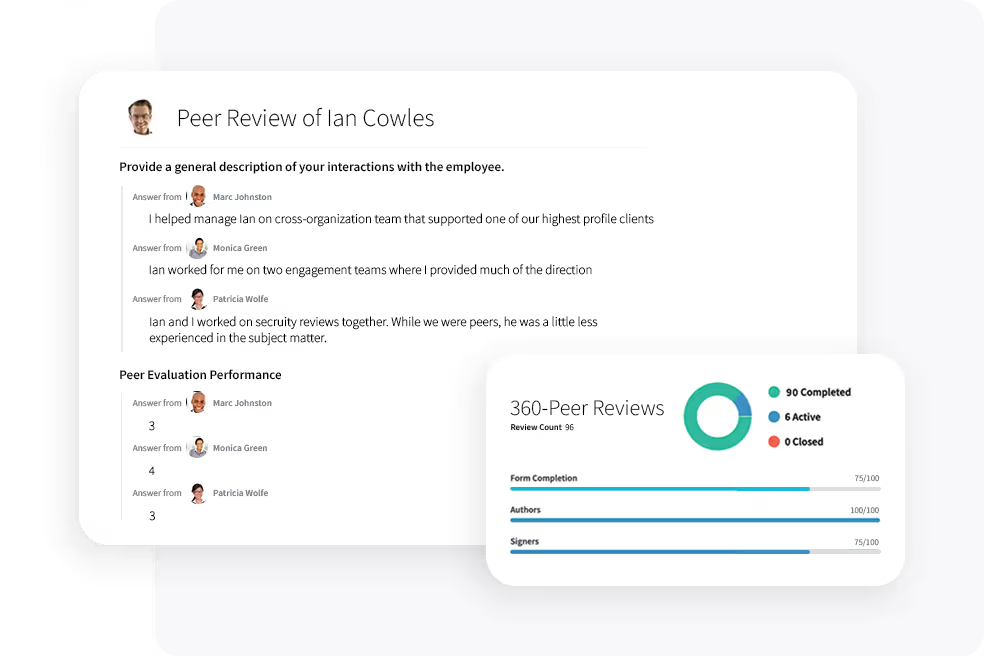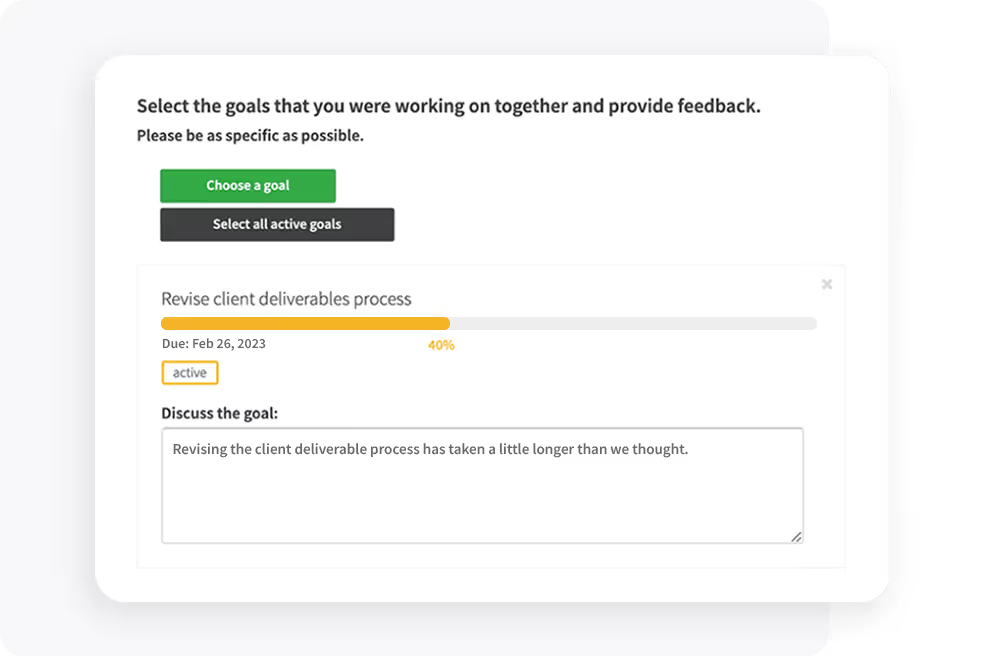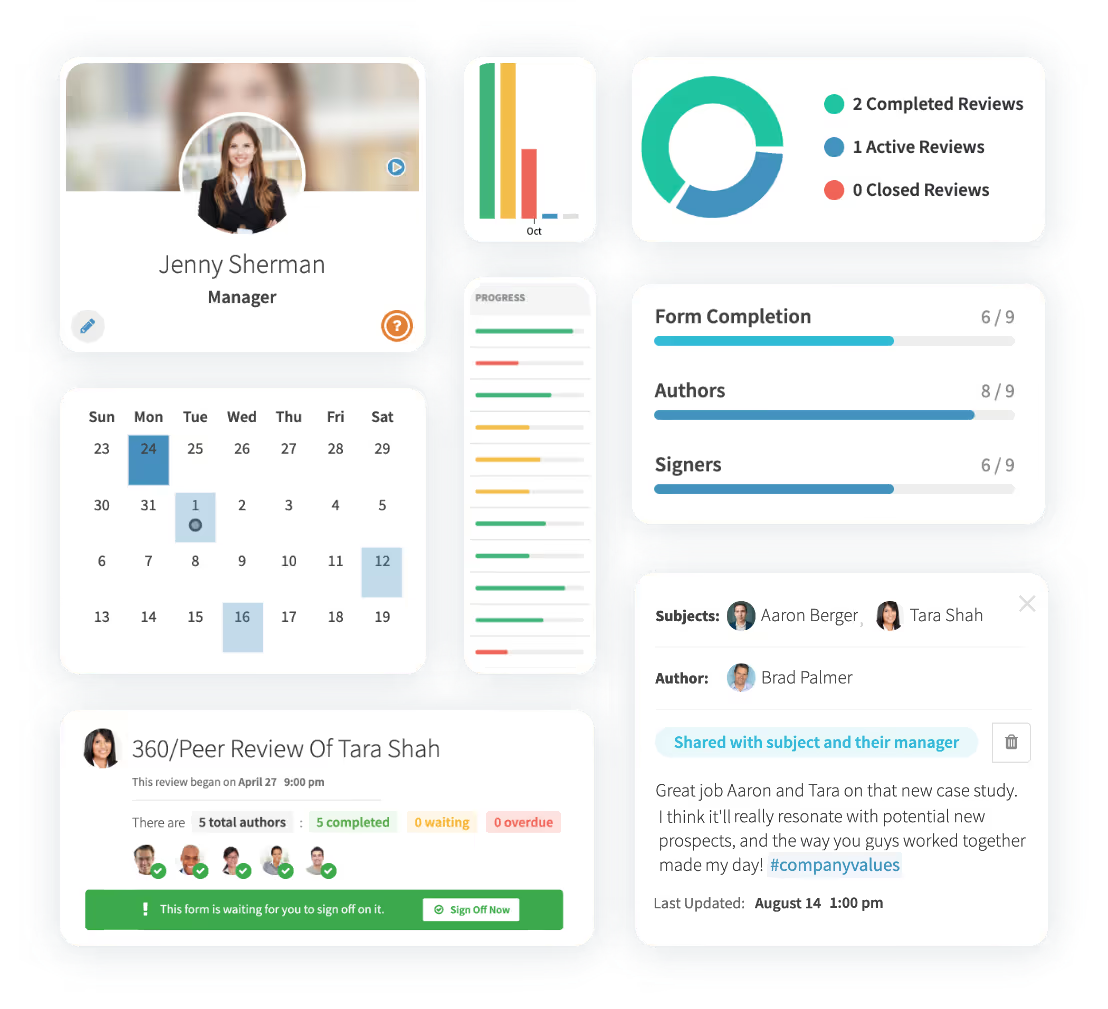Agile Performance Management: Best Practices and Examples
Performance management gives employees and organizations the ability to evolve. Yet so many performance management systems fall flat.
When it comes to traditional performance management, everyone does their part to fill out their annual review. Some employees list the same goals they had last year because they haven’t accomplished them yet. Managers do what they can to get through the latest round of reviews, and once they’re done, everyone can get back to business as usual.
Conducting a review process like that is a waste of time. Do you want performance management to have a real impact on your organization and its people? Then consider pivoting to agile performance management.
Instead of focusing on the process itself, agile performance management focuses on people.
An agile process takes more time and dedication from all those involved. It also helps cultivate meaningful relationships and opens up dialog between managers and staff.
But, what does agile performance management look like? And what steps can you take to create a more agile performance management strategy?
Here’s everything you need to know to run a more agile performance management process in your workplace.
Agile Performance Review Examples
Agile performance management aims to break annual goals down into smaller pieces. The process involves scheduling several check-ins throughout the year. This keeps the lines of communication open and establishes rapport so teams can address challenges quickly.
Checking in more frequently also helps keep employees on track, which makes them more likely to reach their goals.
But this type of review means more than meeting more often. True agile performance review examples have features that you won't find with traditional reviews.
McKinsey is the perfect example of how to do agile performance reviews the right way.
Agile Performance Management at McKinsey
According to McKinsey, five trademarks distinguish agile organizations from more traditional, hierarchical organizations:
- A broad North Star that gives teams and employees a direction to focus, while still outlining their objectives and moving at their own pace
- Empowered teams with limited hierarchies and no middle management that are empowered with a clear purpose
- Rapid decision and learning cycles that encourage risk-taking without the fear of failing
- A dynamic people model that ignites passion through the development of expertise
- Next-generation enabling technology that supports the process, but doesn't become the process
Agile performance management at McKinsey and Company involves linking goals to business priorities. They do this with transparent, team-oriented objectives and investing in managerial coaching skills.
When following these practices, 84% of employees are more likely to think the performance management process is fair. When they believe the process is fair, they are more likely to perform at a high level, and in turn, influence others on their team to do the same.
Benefits of Agile Performance Management
There's a good reason to transition away from traditional performance reviews and take a more agile approach. Management research firm CEB found that 95 percent of managers aren't satisfied with performance reviews. A further 90 percent of HR leaders admit that the process doesn't provide accurate information either.
The benefits of agile performance management can change that.
Most employees prefer the flexibility and transparency of a more agile process. Additionally, many report working more effectively too.
Agile performance management leads to greater productivity. Agile performance management accomplishes this through a supportive process that people like.
Managers take a coaching mindset. They help employees reach their full potential instead of outlining a list of demands. Managers approach employee performance in a more constructive, team-oriented way. All team members give and receive feedback. That means employees can give team leads and managers feedback too.
This approach creates a culture where high performance is achievable by all. It enables companies to better keep top talent and foster an atmosphere of collaboration. Expectations are clear and everyone has the support to reach their goals.
Agile Performance Goal Examples
Not only does the process look different, but the goals also look different too. Agile goals don’t focus on past individual performance. They focus on future performance within a team-oriented atmosphere.
These types of goals outline a clear path to their achievement. Plus, they feel less personal. Goals focus on future tasks and performance—not personal failings. This energizes employees to meet their goals instead of feeling a failure.
But what do these types of goals look like?
Here are a few agile performance goal examples you can refer to when creating goals for yourself and your team.
Deliver three high-quality projects within three months. Maintaining an average customer satisfaction score of 4.5 or above.
This goal is outcome-based and includes a specific metric for success that aligns with the company’s goals. It includes the exact information you need to know to determine if the goal has been met.
It is also team-focused. By outlining how many projects are to be completed, the employee knows exactly how to pull their weight on the team.
Take on additional responsibilities for a new project within one month. Collaborate with a team to develop a solution that reduces costs by 20%
This goal contains a collaborative element, making it team-oriented. It honors the problem-solving process while emphasizing innovation. This encourages the employee to take a risk and try something new.
Like all good goals, it includes an explicit outcome to work towards. It also leaves it up to the employee to figure out how to work towards that goal. The employee has plenty of autonomy.
Learn a new programming language within six months. Apply it to an existing project to improve its functionality.
This goal is outcome-based like the others. That said, it focuses on learning and development while encouraging continuous growth.
It does still include a metric so the employee and their manager know precisely whether they’ve achieved the goal. The goal aligns with the company’s plans but features achievable individual goals along the way.
Key Elements of Agile Performance Management
Traditional performance management approaches feature few meetings or touchpoints. Agile performance management focuses on providing feedback continuously. The process is also much more collaborative.
Every agile performance management strategy features:
- Frequent check-ins
- Continuous feedback
- Detailed goal tracking
- Cascading goals
- A process that is constantly evolving
Frequent check-ins

For performance management to be agile, it has to feature frequent check-ins. How frequently depends on the needs of each team.
Some companies require check-ins once a month, while others might schedule them after the completion of a project. Others may simply schedule them as needed.
No matter how often they happen, check-ins should keep the lines of communication open. This helps employees and managers feel comfortable talking about performance challenges.
That means check-ins also tend to be more informal than traditional reviews. They have a relaxed agenda that makes it easy to plan for a check-in meeting.
Continuous feedback

Continuous feedback doesn't have to be a daunting task. Continuous feedback simply means providing feedback regularly.
Managers can provide feedback at check-in meetings. They can provide it within a performance management platform for the employee to access at their convenience. Continuous feedback can be provided at the moment. It can also be ad-hoc, with suggestion boxes and engagement surveys to inform formal feedback.
Involve employees in figuring out how often and what type of feedback to provide and they will be much more engaged in the process.
Detailed goal tracking

With more check-ins and continuous feedback, you have the opportunity for more detailed goal tracking.
That said, goal tracking is about more than how often you provide feedback. It requires you to record information regularly.
Outcome-based goals allow you to see which goals are being met. If they aren't, you can talk about what might be preventing success.
It keeps everyone on track throughout the process. People also have support along the way, so no one waits weeks or even months to find out that a particular goal is causing problems.
It also enables you to pivot if a goal becomes outdated. You can make new goals if employees hit a previous goal early, adjust goals if they’re outdated, or scrap them altogether.
Cascading goals

Cascading goals means starting with the organization’s goals instead of the employees.
These goals encompass the big picture. They start with the company’s goals, then break them down into clear tasks and deliverables for employees.
Without cascading goals, you may find that employees hit their goals without helping the company hit its goals. Cascading goals ensure everyone’s goals are aligned so they contribute to the greater goals of the company.
The process that is constantly evolving
The point of agile performance management is that it’s agile! That means the process must constantly evolve.
If something isn’t working, change it. That could include the frequency of meetings, the goals themselves, or the process of giving feedback. Agile performance management aims to grow and evolve so that it best serves employees, managers, and the company as a whole.
The Difference Between Agile and Traditional Performance Management
On the surface, traditional performance management and agile performance management appear the same. They both focus on achieving goals, they both include a review process, and they both offer up feedback.
The execution is what makes them different.
Traditional performance management is very static. It is a set-in-stone process that usually involves an annual review, with little or no time to reflect or receive feedback between reviews. It takes a top-down approach. Management acts as the facilitator, handing out goals and measuring goal completion.
In contrast, agile performance management changes depending on needs. Reviews may take place annually, but informal check-ins take place throughout the year. The system is collaborative. Employees join the goal-creation process and offer feedback of their own.
Taking an agile approach to performance management leads to improved outcomes. After all, there must be a reason why over 70 percent of companies have adopted a more agile approach.
Among those who receive weekly check-ins, 85% report being more engaged as a direct result of the feedback they receive. After adopting an agile approach, 60 percent of companies experienced profit growth. Companies with continuous performance management outperformed competitors by 24 percent.
Not to mention, a collaborative performance management process can positively impact company culture. Employees will feel valued. The more valued they feel, the more they contribute to the team.
The Role of Software in Agile Performance Management
An agile performance management system can feel like a lot to keep track of. And it is if you’re tracking goals in an Excel document and hunting down feedback from emails.
To be truly agile, you need a platform that supports all your processes. Those may include continuous feedback, goal tracking, cascading goals, and frequent check-ins.
A software program like PerformYard streamlines the entire process on a single platform. It helps you track the completion of goals in real-time. PerformYard also acts as a central depository for feedback. It can even help you collect and display data without crunching the numbers by hand.

PerformYard can help you run a dynamic and ever-changing performance management process with ease.
A lot goes into an agile performance management process. You’ll have to schedule frequent check-ins and provide continuous feedback. You might also want to track cascading goals. Fortunately, PerformYard streamlines all these processes and more.
An agile process evolves, which means you can focus on creating a system of check-ins before you track goals. It’s okay to master one thing at a time before adding another agile feature to the process.
Even after you start running every aspect of an agile process, you may realize you need to pivot again, and that’s okay! An agile performance management system is all about serving the needs of your employees, managers, and the company.


.jpg)

.jpg)
